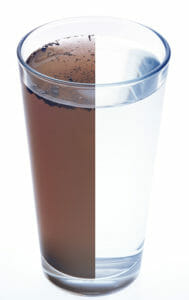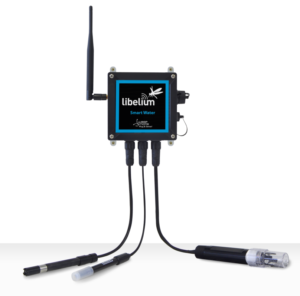
We regularly speak to customers who have a requirement to measure turbidity levels in water supplies, rivers and other bodies of water. IoT is a powerful and cost-effective way to measure turbidity and transmit the results for analysis, visualisation and reporting.
Turbidity is the loss of transparency, cloudiness or haziness of fluid due to the presence of particles that are invisible to the human eye. These suspended solids cause the water to appear murkier, as the turbidity increases. Smart water solutions and IoT have specialist sensors that can measure turbidity levels.
How do you measure Turbidity?

There are different cases where you may want to measure Turbidity. Before we look at a few examples, it is worth explaining the unit of measurement used for Turbidity. Nephelometric Turbidity Units (NTU) is the measurement of turbidity, achieved by shining a light beam through the fluid and measuring the amount of scatter or reflection experienced due to the presence of particles. The Smart Water sensors from Libelium primarily measure Turbidity using NTU.
(There are other units and methods of measurement including Jackson Turbidity Unit (JTU), Secchi disk and Formazin Turbidity Unit). Measuring turbidity with IoT is one example of Smart Water technologies. We work with our partner Libelium to provide Smart Water solutions that include Turbidity sensors.
Turbidity measurement examples
Drinking-Water – Mains Supply

Health authorities and Governments prescribe limits to what they believe are acceptable levels of turbidity for drinking water (measured in NTU). Water with high levels of turbidity, not only looks unappealing, but it can also increase the risk of pathogens and other undesirable factors in the water. Although not directly a health risk, turbidity still has an essential element in drinking water supplies.
- The EU Drinking Water Directive (98/83/EC) sets a figure of 4 NTU as acceptable.
- Similar to the EU, the UK and Ireland, the maximum levels of turbidity for drinking water are 4 NTU (measured at the consumers’ taps). At the treatment works, the target is 1 NTU. See DEFRA standards document here (pdf).
- The WHO recommends drinking water should have a turbidity of 5 NTU or less. Where the water is chlorinated, the NTU levels should be <1 NTU for the chlorination to be effective.
- In the US the turbidity cannot exceed 1 NTU at the plant outlet, and most drinking water utilities aim for levels as low as 0.1 NTU.
For water treatment to be useful (such as chlorination), the turbidity levels of the water need to be at an adequate level. If turbidity is high, households will also reject the water supply based on appearance. The Libelium Smart Water Pro and Smart Water Xtreme can be deployed to monitor the turbidity levels of water at the household, network or utility level.
Drinking-Water – Private Supply
Many households still use private supplies for their everyday water needs. These private supplies may include wells, streams or boreholes. Much like mains water, it is essential to measure the turbidity of supplies to ensure treatment is effective, filters are not blocked and that the overall quality of the water supply is known.
Utilities
Many utility suppliers employ different treatment systems to manage turbidity; these can include sedimentors, coagulators and gravel pre-filters. These systems are designed to remove particles from the water and improve the NTU value. Measuring the turbidity of the water before and after the filtration stage is an excellent way to determine their operation and effectiveness. With the standards set for drinking water; real-time and accurate turbidity measurements are invaluable to utility providers. When a utility is responsible for so many bodies of water and an extensive network, monitoring water quality and turbidity with IoT becomes a valuable tool.
Rivers and Lakes
During heavy rain showers, you may see clouds of dirt and silt in rivers – this is an indication that both turbidity and suspended solids may have increased. Unlike drinking water, which has stringent targets of 1NTU or lower – water bodies have more modest goals in regards to turbidity. The exact levels vary by country and state; however, it is not unusual to see turbidity limits range from anywhere between 5 NTU and 150 NTU.
A river or lake can suffer from high turbidity due to the presence of silt, algae or other pollutants. High turbidity levels can block out light, impact vegetation, water temperature and the overall health of the water body. The particles causing high levels may also cause an increase in pollutants, metals and bacteria. As a general rule – turbidity can provide an indicator as to the pollution levels of water.
Cows(!) can also cause a rise in turbidity at cattle access points – as this presentation from Dr Ciprian Briciu Burghina has shown.
Fishing ponds/lakes
Turbidity levels play an essential role in the health of fish and other animals. High levels of turbidity impair the vision of predators and prey, which can be disruptive to an ecosystem – if lifeforms are unable to hunt and feed. Turbidity can impact foraging patterns and movement through a water body – as fish are unable to assess their surroundings suitably.
Put another way, imagine trying to swim around a lake that was full of silt – while looking for treasure – this would be impossible to achieve. Operators of fishing lakes and ponds should, alongside other measurements, monitor turbidity levels.
How can I measure Turbidity with IoT?

The Libelium Smart Water Plug & Sense solution has several sensors that can monitor turbidity:
- The entry-level turbidity sensor can take measurements from 0-4000 NTU, with an accuracy of 1 NTU. The sensor is made from plastic/stainless steel and is suitable for freshwater or drinking water applications.
- We also have a similar sensor, but this time made from titanium, which is designed to be deployed in sea-water or ocean environments.
- The Manta 40 probe features a turbidity sensor that is accurate to 0.1 NTU and has an operating range of 0-2500 NTU. The Manta is perfect for applications where high levels of accuracy are required. The Manta also features a self-cleaning system which reduces the overall maintenance and overhead of the system.
Once the sensors are deployed (typically on a 5m cable), measurements are taken and transmitted back to a cloud platform or database system. The flexible nature of Plug & Sense means alongside the sensors, you can choose from 3G/4G, Zigbee, WIFI, LoRa or Sigfox communication protocols.
Turbidity data can be viewed on dashboards, visualised or sent using reports. In the event levels increase, alerts and alarms can be generated.
FAQ
- What depth can I measure Turbidity? Sensors have a 5m cable by standard.
- Are they suitable for seawater measurements or harsh environments? Yes. The Libelium One and Plug & Sense is IP67 rated and as the sensor cables are 5m in length, the unit can be positioned away from harsh elements. The turbidity sensors have both stainless steel and titanium models depending on saltwater vs freshwater.
- How do they send data back? The Libelium One and Plug and Sense has support for 3G/4G, WIFI, LoRa, Sigfox and Zigbee.
Find out more
If you are a local council, utility supplier, fishing pond manager or wish to monitor your turbidity levels with IoT – then please get in touch. MTG works with systems integrators and end-users, to design and deploy IoT Smart Water solutions. Speak to our knowledgeable pre-sales team today to advance your IoT solution.
You can speak to our sales team by calling +44 1624 777837, e-mail sales@mtg.im or click Request a Quote.
Further Reading
- IoT – Smart Water Applications
- Internet of Things (IoT) and ISO 37122 – A perfect partnership
- IoT Case Studies
- Libelium Plug & Sense

